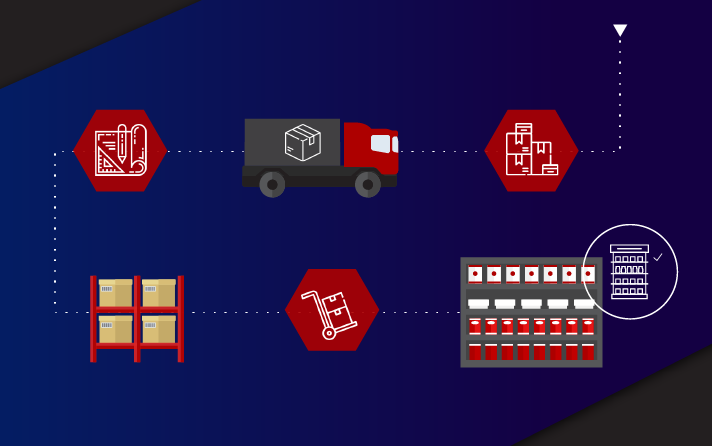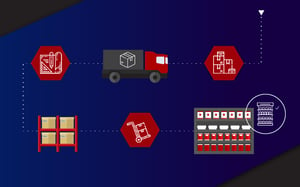
When you start listing products with a retailer, you’ll no doubt begin with limited retail space. This initial allocation depends as much on your negotiation skills as a small supplier, as it does on your products. But let’s say a retailer has only given you a handful of facings, and you want more. Luckily, you can negotiate for it.
While you might be a small supplier, you can compete against larger suppliers and increase your retail space.
What does that mean exactly? In short, you need to answer a series of questions about your supply business. By answering them, you place yourself in a strong position when the time comes to negotiate for more space. More importantly, you’ll be prepared.
1. What need are you fulfilling?
Considering how congested retail shelves are today, if you want more space for your product, you can’t merely say you deserve it. Instead, you need to be able to justify it.
But how do you do that?
You can start by positioning yourself within the market and understanding your target customer and what they want or need. Above that, you also need to know what value you can add to the retailer. What is your value proposition? Are you priced better than your competitors? Can you offer a product that a buyer can’t get elsewhere? Is your product of better quality?
Since a buyer won’t bring in a new line just because it exists, you need to know how you can position your product to motivate for more retail space.
Let’s take the example of two products in the Cereals category to explain our point further.
Product A and Product B are like-for-like, except for one thing. Product A comes in a compact package, which takes up less space on the shelf than Product B. In this case, your value per cubic centimetre occupied on the shelf is an excellent reason to give more space to Product A as there is more value gained using less space.
That means it’s a great value proposition, and especially so if you look at the Cereals category across 1000 stores rather than just one. If a retail buyer can see a clear value proposition, it becomes that much easier for you to extend your existing listing further.
As a side note, your value proposition isn’t limited to your product or even your packaging. It includes the technology that supports your product, and a buyer considers, amongst other factors, how easy and efficient it is to get the product to distribution centres and onto shelves.
2. Is your business sustainable?
Once you’ve established your value proposition, a second question to tackle revolves around business sustainability. Now, from your vantage point as a small supplier who is trying to make their way in the retail world, you might feel offended or intimidated if such a question comes up. There’s nothing wrong with that.
However, you need to look at this as if you were the retailer.
If we’re talking about a well-established retailer, they’ll have created a strong brand around their business. Their customers have expectations that they must fulfil. And, since they’re ultimately accountable for what goes on in their store, they’ll protect the brand at all costs.
By the way, when we mention business sustainability, we’re referring specifically to the health of your supply business rather than any of your business practices. Of course, that’s another question which requires answering too.
If a retailer is going to list a new line, which happens to be your product, before they do that, they’ll need assurances that you won’t suddenly go bust or stop manufacturing the product. It’s been known to happen.
Just imagine the scenario in which customers begin buying and enjoying your product regularly and suddenly, it’s no longer available. Shoppers aren’t going to get angry with you, the supplier. They’ll complain to the retailer.
If you can prove the sustainability of your business, what you are doing is alleviating the fear that while you have a great product that customers want to buy, you’re not going to go out of business. Also, if you can show this to the retailer, you have a better chance of increasing your space than another supplier who can’t make that guarantee.
The key here is being able to prove that your business is sustainable and stable.
3. Are you legislatively compliant in all shapes and forms?
Can you imagine a retailer listing a product in-store only to find out later that it’s poisonous (food) or hazardous (children’s toy) and they need to recall it or face litigation? Or, the product doesn’t comply with industry standards, and it’s non-compliant in any way from a health and safety point of view.
It’s been known to happen and is why some retailers are uncertain about taking on a new listing from an unknown or small supplier.
Thus before approaching a retailer to negotiate for retail space (or request for an initial listing), you need to ensure you have robust health, safety and labour policies in place. That includes looking at your factory or warehouse. Is your factory compliant? Is your machinery up to industry standards? Are you adhering to local and international labour and safety laws?
Of course, it's more than just compliance at a factory or labour level. It’s also about the actual ingredients you use.
Improve your shelf inventory replenishment efficiency with DotActiv Lite
Let’s say, for example, one of the ingredients of your product is Caffeine. In the case of caffeine, it’s a regulated substance so you’d need to list it as an ingredient in your product. If you don’t, you’ll soon run in trouble, which includes legislative territory. Again, it’s the retailer who will take the slack rather than you, the supplier.
In today’s fast-paced environment, and especially in the age of social media, if a retailer associates themselves with you and you break any socially unacceptable norms and their customers find out, their brand is damaged.
It’s precisely why a buyer will visit your factory to ensure compliance. They’ll test everything to ensure that it’s all up to standard.
It should be noted that compliance does differ depending on the category. For example, compliance orders are far stricter when it comes to pharmaceutical products as opposed to general merchandise. That said, each category and product have standards that you must observe.
It is one thing to be legislatively compliant but another to have the information about your compliance readily available in a compelling format. Retailers are going to ask about your compliance so be ready to answer and show that you have your house in order.
4. Is your supply chain under control?
While you need to be compliant around health, safety and labour laws, it’s just as crucial for you to be aware of and in control of your supply chain.
The reason for that is simple: Let’s say you manufacture and supply foodstuffs. If you do, you’d need to understand batch control so that later on, if something is shown to be faulty, and a complaint comes through, you can trace it all the way back.
For example, if you delivered a batch to Retailers A, B and C and you later find that someone reported a fault in Retailer B, you’ll know where to begin. You can then pull back the entire batch from Retailer B or from all three retailers.
There was a recent issue that occurred in South Africa around an outbreak and the effect it had on the processed meat industry. Fortunately, in that case, the supplier knew which batches had gone where so they could recall their product without too much trouble.
Maximise the selling potential of your shelf space and reduce out of stocks with DotActiv Lite
You can only imagine the consequences of being that small supplier who doesn’t have control of their supply chain, and you had to face an outbreak of this nature. For one, you won’t have any idea of which products to pull or even where to start. Secondly, you could very well destroy a retailer’s brand (along with your own).
Likewise, if a retailer finds out while working with you that you don’t have control, there is very little chance of you getting more space. If you have a product listing already and they find out, there is also every possibility of the retailer deranging your brand to guard against any future issues.
5. Do you understand the negotiation terms?
As a small supplier, the chances are good that you don’t have merchandising or sales infrastructure in place. You’re also unlikely to know who to approach to take on your product to sell to a retailer. This can be to your disadvantage.
For example, while you might approach an agency to help you distribute your products, because you have so few, and the agency happens to be large, it’s possible that you won’t get the service levels required to drive your products.
What could end up happening is because you don’t have the experience when you walk into any negotiation with a buyer, they’re likely to intimidate you before you even start.
But, if you can familiarise yourself with all the relevant negotiation terms and the accompanying fees before you approach an agent or buyer, you’ll be in a stronger position. As we noted above, you’d be better prepared and confident in your approach.
There are many different fees that retailers create to build their margin.
A few terms that you should familiarise yourself with include Target Discounts, Trade Rebates, Payment Terms, Distribution Centre fees, Promotional Spend, and Settlement Discount. You can read more about each term in this piece.
6. What value are you adding other than a great product?
While the quality and price of your product matter, it’s crucial to understand that there are other ways that you can add value. In finding these other opportunities, you can influence a retailer not only to list more of your products but give them more space and favourable positioning on the shelf.
But what other actions can you take that leads to more value?
You can look to invest in an in-house planogram capability. This allows you to offer data-driven planograms that improve category performance. While the retailer wins because you’re helping them to grow the category, you do too since you can influence the space allocations and positioning of your products.
Of course, you do need to be fair when deciding on the space and position of each product, lest another supplier accuses you of favouritism.
Besides that, another way to add value is to provide a merchandising team that can help to get products onto shelves. Since many retailers aren’t responsible for the actual packing of products, it's a great way to add value. More than that, it shows the retailer that you’re fully invested in presenting the category to maximise sales and profitability.
Conclusion
If you’re a small supplier looking to increase shelf space allocations for your products, then our Introduction to Retail online short course is a must. The course covers the concepts of Days of Supply on the shelf, Space Elastic Demand, Product Placement and more. Learn more here or book your custom exploratory consultation here.


